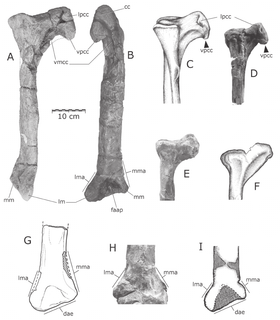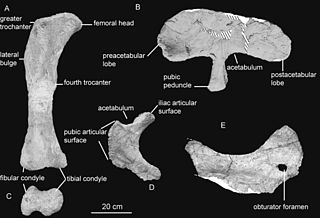 W
WThe Allen Formation is a geological formation in Argentina whose strata date back to the Late Cretaceous (middle Campanian to early Maastrichtian. Dinosaur remains are among the fossils that have been recovered from the formation.
 W
WAeolosaurus is a genus of titanosaurian sauropod dinosaur from the Late Cretaceous Period of what is now South America. Like most sauropods, it would have been a quadrupedal herbivore with a long neck and tail. Aeolosaurus is well known for a titanosaur, as it is represented by the remains of several individuals belonging to at least three species. However, like most titanosaurs, no remains of the skull are known. The holotype of Aeolosaurus rionegrinus consists of a series of seven tail vertebrae, as well as parts of both forelimbs and the right hindlimb. It was discovered in the Angostura Colorada Formation in Argentina, which dates from the Campanian stage of the Late Cretaceous, about 83 to 74 million years ago.
 W
WAerotitan is a genus of large azhdarchid pterosaur known from the Late Cretaceous period of what is now the Allen Formation of the Neuquén Basin in northern Patagonia, Argentina.
 W
WAustroraptor is a genus of dromaeosaurid theropod dinosaur that lived during the Late Cretaceous Period in what is now Argentina. Austroraptor was a medium-sized, moderately-built, ground-dwelling, bipedal carnivore. It is one of the largest dromaeosaurids known, with only Achillobator, Dakotaraptor, and Utahraptor approaching or surpassing it in length.
 W
WLamarquesaurus is an extinct genus of sphenodontian from the Late Cretaceous (Campanian) of Patagonia. It is known from a single species, Lamarquesaurus cabazai. This genus and species is represented by MML-PV-42, a well-preserved right maxillary bone. This bone was found at the Cerro Tortuga site near Lamarque, Argentina, which preserves fossils from the Cretaceous Allen Formation. The discoverer of the Cerro Tortuga locality, Tito Cabaza, is the namesake of the species.
 W
WLaplatasaurus is a genus of titanosaurian sauropod dinosaur that lived during the Late Cretaceous in South America.
 W
WPellegrinisaurus is a genus of titanosaurian sauropod dinosaur that lived in South America during the Late Cretaceous period. The holotype was found in the Allen Formation, Argentina.
 W
WQuilmesaurus is a genus of carnivorous theropod dinosaur from the Patagonian Upper Cretaceous of Argentina. It was a member of Abelisauridae, closely related to genera such as Carnotaurus. The only known remains of this genus are leg bones which share certain similarities to a variety of abelisaurids. However, these bones lack unique features, which may render Quilmesaurus a nomen vanum.
 W
WRocasaurus is a genus of titanosaurian sauropod that lived in South America. Rocasaurus was discovered in Argentina in 2000, within the Allen Formation which is dated to be middle Campanian to early Maastrichtian in age. This genus grew up to 8 metres (26 ft) long, making it one of the smaller sauropods. It seems to be closely related to saltasaurid dinosaurs, like Saltasaurus and Neuquensaurus.
 W
WSaltasaurus is a genus of titanosaurid sauropod dinosaur of the Late Cretaceous Period of Argentina. Small among sauropods, though still heavy by the standards of modern creatures, Saltasaurus was characterized by a short neck and stubby limbs. It was the first genus of sauropod known to possess armour of bony plates embedded in its skin. Such small bony plates, called osteoderms, have since been found on other titanosaurids.